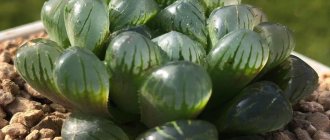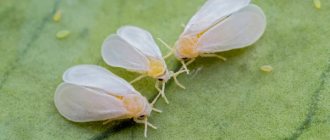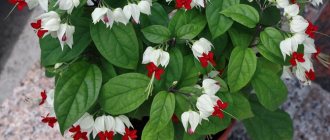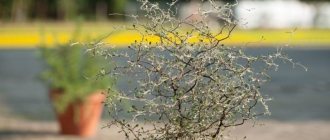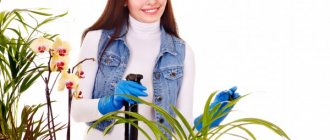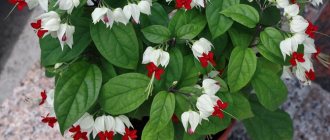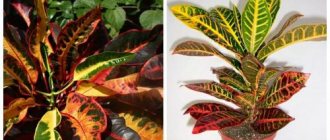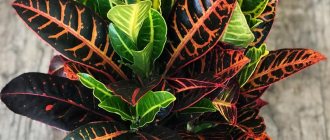Houseplants
Indoor plants are very diverse. Their homeland is warm countries where they live in nature. We breed them in our houses and greenhouses.
We met these plants in first grade. Recognize them by their silhouettes. Indicate the names with arrows.
Seryozha has come up with a difficult but interesting task for you. Using the atlas-identifier “From Earth to Sky”, select indoor plants whose names begin with the first 5 letters of the alphabet (one for each letter). Write these names. A - asparagus, aspidistra, aloe, Amazonian lily, abutilon B - begonia, balsam C - upstart, wallot, vanda, Washingtonia D - hippeastrum, gloxinia, geranium, hydrangea D - dracaena, dendrobium, wildflower, dorsthenia
Using the atlas-identifier “From Earth to Sky”, fill out the table.
Houseplants in our class
Practical work “Learning to care for indoor plants.”
Purpose of work: learn how to care for indoor plants
Equipment (what plant care products were used): watering can, sprayer, stick, sponge or cloth.
Progress of work (what actions were performed): watering, spraying, loosening the soil, wiping the leaves with a damp sponge or damp rag.
Evaluating the work done (whether the goal was achieved): learned how to properly care for the plant. Goal achieved
Using the atlas-identifier “From Earth to Sky”, as well as (if necessary) other literature on floriculture, fill out the table.
Houseplants in my home
Using the atlas-identifier “From Earth to Sky”, as well as other literature (if necessary) on floriculture, fill out the table Name of the plant/Homeland of the plant according to the example:
Not every housewife is involved in floriculture, so some have window sills that are “bursting” with flowers, while others are “filled with flowers.”
If you have few flowers or don’t know their names, then turn to the Internet. Basically, all plants are the same, but there may be rare exceptions. There are flowering plants, and there are simply beautiful foliage.
Let's fill out the table “Name of the plant / Homeland of the plant” about the plants in my room
Dieffenbachia / Central and South America
Alocasia / Asia, Eastern Australia
Geranium / South Africa
To fill out the table in the workbook The world around us, grade 2 by Pleshakov, you need to look at what indoor flowers you have on the windowsill, then write the name of the flower in the first column of the table “Name of the plant”, and in the second column “Homeland of the plant” write the country where its homeland is .
It is enough to write at least three plants.
If you don’t have indoor plants at home, then use this example.
I think that the greatest difficulty of this task is to know exactly what the names of the flowers that grow on windowsills at home are, because not everyone knows the names. It’s a beautiful flower, okay, but what it’s called is a secondary matter.
Therefore, for example, I will give both the name of the flower and its photo, so that it is easier for you to recognize it among your flowers (if you have one, of course). And just by the name, it’s not at all difficult to find the flower’s homeland.
Let's name some of the indoor plants and flowers.
Begonia The tropics and subtropics of Africa, Asia, and America are considered the homeland of this flower.
Fuchsia - New Zealand and South America
Ficus - Asia, Africa.
Sansevieria (pike tail, mother-in-law's tongue). Homeland - the tropics of West Africa.
Phalaenopsis. Philippines, etc.
Anthurium. Central and South America.
Nowadays, amateur flower growers have the opportunity to grow many exotic flowers at home. To create the same conditions for subtropical, tropical or even desert indoor plants as in their homeland, you need to know the climate of the area in which they grow in the wild. Then green “aliens” from distant countries and continents will be able to fully delight with their unusual beauty.
House plants: properties, usefulness and harm
Many years of practice and experience confirm the sanitary, aesthetic and hygienic role of most indoor plants. They help clean the air from carbon dioxide. It is usually 23 times more abundant indoors than outdoors.
Thanks to flowers, the air is enriched with oxygen. The leaves of indoor plants evaporate moisture, humidifying the air and reducing its temperature.
Natural green color has a beneficial effect on the nervous system and psyche. People's mood and performance improves.
Particularly valuable are plants that secrete essential oils and phytoncides that have the ability to kill pathogens. About 50 species of such indoor plants are currently known. Doctors together with chemists and botanists study their properties.
There are also “doctors” among them (for example, aloe and kalanchoe, golden mustache and geranium).
You should not grow poisonous plants at home, and if you have them, handle them with caution. These include milkweed, oleander, alocasia and acalypha. If you like such indoor plants and look good, it is advisable to place them in a place inaccessible to children, and be careful when in contact with them.
First documentary mentions
There are many different documentary references to these beautiful flowers:
- In ancient China and Japan, orchid plants are used as medicinal plants, and the hieroglyph “lan” is assigned to them;
- There is amber, inside of which a bee was found with an adherent structure necessary for the production of orchid pollen. The age of this amber is 18 million years;
- There is a treatise of Chinese origin , written in 1590 on Medical Issues, which mentions orchids as a wonderful remedy for expelling evil spirits.
IMPORTANT! The common ancestor of all orchid plants grew in the Late Cretaceous Age, which is 76-84 million years ago.
Kinds
Houseplants, according to their decorative properties, are usually divided into 3 large groups. The plants of the first two are decorative-leaved and decorative-flowering indoor plants that do not lose their attractiveness throughout the year. The third group is ornamental flowering plants that attract attention only during flowering periods.
In addition to all this, among the plants grown at home, there are separate groups: palm trees, orchids, bromeliads, cacti and succulents, ferns, bulbous plants, and also fruit-bearing plants.
The most popular plants that came to us from the dry subtropics
Shrubs and trees:
Akka Zellova
Fuchsia
South Cordilina
Herbaceous species of decorative deciduous and decorative flowering:
All types of begonias
Clivia
Brovalia
Oleanders
Caring for indoor plants: rules
- Roots need not only water, but also air. Overmoistening of the soil leads to death or disease.
- In winter and late autumn, the air in rooms, mainly with central heating, is dry. You need to learn how to properly maintain its humidity.
- Almost all indoor plants require a certain period of rest. At this time, they should be watered less often and fed a little less. You also need to ensure a lower air temperature than during the period of active growth.
- A couple of years after planting, most plants lose their attractiveness. In this case, it is enough to simply transplant the flower into a larger pot.
- When caring for plants, the following tools are needed: a watering can with a narrow long spout, a sprayer, an old fork and spoon, pruning shears, a soft sponge. Good soil, pots, supports, pallets, liquid fertilizers in bottles - this is all that is needed for proper care of flowers.
- If the plant is flooded for a long time, it may die. Same with pests. If a couple of scale insects or any other insects appear, it is not difficult to fight them. And when they cover the entire plant, they cannot be defeated. This means that you should promptly recognize any future troubles for the plant and take the necessary measures to successfully combat them.
- When choosing flowers to grow indoors, be sure to take into account the conditions provided for them. There are light-loving and shade-tolerant plants.
The most beautiful blooming indoor flowers photos and names
In nature, there are many domestic crops grown on windowsills. This section presents flowers with bright inflorescences that do not stop blooming almost all year round.
Begonia
Not a capricious houseplant that blooms all year round. Begonia blooms with lush inflorescences all year round with proper care. The flower loves light and is undemanding to soil and temperature conditions. In the summer it is taken out onto the loggia without harm to health. Transplanted by cuttings. To make the crop lush, it is pruned.
Abutilone
Thanks to its leaves, the home flower received the name “indoor maple” among gardeners. The plant is not whimsical; it requires constant, careful watering and good daylight. The best soil for flowers is deciduous humus with sand, turf, and mature manure. For abundant flowering, abuliton is fed with superphosphates and saltpeter. Will require pruning in spring. Propagated by cuttings.
Hibiscus
A picky indoor shrub that grows in houses up to 2 m. It blooms from spring to autumn with large flowers of whitish, bright red, and pink colors. The plant is sun-loving. In summer it requires good watering. In winter, the culture is kept at a temperature of 16-17C. Propagated by cuttings. Suitable soil: humus/peat, turf, a little sand. In spring, the flower is pruned to form a bush shape.
Anthurium
The plant is divided into decorative deciduous crops and flowering ones. Blooms in light red, crimson, red. Loves light and thermometer division not lower than 18C, moderate watering. Flowers do not mind irrigation. They are planted by cuttings and cutting off the side stems. The substrate must be drained.
Clivia
The indoor flower is characterized by dark green leaves. During flowering, a long stalk with yellow-orange buds is formed on it. The plant tolerates shade. With fertilizing, clivia will bloom even in a dark room. The crop is propagated by root “babies”, separating them from their parents and planting them in a substrate of sand, turf, or leaf soil.
Indoor roses
An ornamental plant that prefers plenty of light does not tolerate overheating. House flowers come in a variety of colors. After acquisition, the crop is immediately transplanted into nutrient soil. In favorable conditions, the rose blooms all year round with a short break.
The flower takes watering well; it is important not to let the soil dry out. Feed indoor roses every two weeks. Prune the plant by removing faded buds, dry leaves and branches.
Pelargonium
Blooms with bright exotic balls (dormant period November-February). The plant's homeland is South America. In total there are from 280 to 350 species. The essential oil of the flower kills harmful bacteria and helps purify the air in the house. The culture is not fussy to care for and loves light. Water pelargonium sparingly without over-watering. To prevent the flower from stretching, it is trimmed into a neat bush. Propagated by seeds and cuttings.
Kalanchoe
The most amazing indoor flower. Considered a succulent. Homeland is Madagascar, Australia, southern Africa. All varieties of Kalanchoe are grown in pots. The plant is sun-loving. Temperatures for growing Kalanchoe in summer are 20-25C, in winter - 15-18C. Water the plant rarely, but abundantly. Feed with fertilizers for cacti. After flowering, prune. Reproduction occurs by seeds, cuttings, “babies”.
Saintpaulia
Another name for the flower is Uzambara violet. Refers to perennial herbaceous plants. Small exotic indoor flowers tolerate shade and are unpretentious. Blooms almost all year round. East Africa is considered the birthplace of the plant. Today, the originators have developed many varieties and types of flowers that differ in external characteristics. The best conditions for growing crops: temperature 16-24C, humidity 60-70%, no draft. Water the “queen of flowers” moderately (you can put it in the tray of a flowerpot). Spraying is contraindicated. Propagated by small bushes.
News from the homeland of indoor plants: what do you need to know?
Where did house plants come from and where do they grow in nature? Let's look at some of them.
- The flowering ornamental plant verbena is a perennial from the verbena family. Her homeland is America. It is used both in pot culture and when decorating flower beds on open ground.
- The evergreen gardenia shrub is a jasmine plant (180 cm) from the Rubiaceae family. Its homeland is the subtropics of China, Africa, Japan, and Asia.
- Gerbera from the Asteraceae family is native to South Africa. It is also grown both for cutting and at home.
- Hibiscus (Malvaceae family) comes from the tropics and subtropics of southeast Asia (Southern China), Polynesia, and northern India. Its entire genus numbers approximately 300 species. It should be noted that this plant lives for more than 20 years.
- Hydrangea (Hortensia family) grows naturally in China. It has been in culture since the end of the 18th century.
- Primrose from the Primrose family, uniting about 20 genera, is distributed mainly in the temperate zone of the Northern Hemisphere. Japan and China are the birthplace of the flower. There are more than 600 species in total.
The world of indoor plants is amazing and beautiful. Flowers not only decorate the design of any room and give it coziness, but also delight the eye all year round, reminding us in a snowy winter of the variety of colors of nature.
Indoor trees. The most popular living trees growing at home or in an apartment in a pot
Indoor living trees, unlike other indoor flowers, have a central trunk and branches. Some of them bloom at home, in other cases the tree has a lush crown. Thanks to pruning, they can be shaped. The most popular is to create Bonsai from them. Indoor pets perform a decorative function and, in addition, freshen the air.
They are used for landscaping apartments, offices and commercial premises. Large, beautifully flowering, and deciduous trees can come in a variety of shapes. They also differ in the shape and color of the leaves. Features of the most popular species that grow in flower pots will allow you to turn your room into a blooming garden.
A coffee tree
A unique plant of its kind with beautiful foliage. At home, it blooms and pleases all year round with its greenery. In place of the inflorescences, berries are later formed. The leaves appear dense, shiny and textured.
A coffee tree
With proper care, its height can reach 1 meter. The crown is formed by pinching. It tolerates drought well; it is recommended to wipe the leaves with a damp cloth.
Monstera
Monstera is a common indoor flower in apartments. An adult tree is quite tall and spreading. The leaves are large, with symmetrical slits. The color of the leaves is bright green and shiny. The monstera leaf is dark green in color and shiny. Over time, aerial roots form in the lower part. There is no need to remove them; they provide the plant with support and additional nutrition. Blooms rarely, with white inflorescences.
Monstera is suitable for large spaces. The height can reach 3-5 meters.
Bonsai
The spread of the indoor tree in a flat pot originated in China, later in the West and Japan. The creation of Bonsai has become a whole science. A miniature copy of a tree with a powerful crown has its own characteristics.
- Bonsai is considered to be an indoor plant with a strong trunk and a well-developed root system;
- the branches must have a clear outline, they can have a curved shape;
- the trunk should not be hidden in the foliage; its ratio is kept to a minimum;
- The pot used is flat, often clay, and discreetly colored.
Florists will classify bonsai by size and shape. Care requires some knowledge of the characteristics of this variety.
Lemon
An exotic houseplant is not only beautiful, but also useful. With proper care, it bears fruit all year round. There are many varieties, they differ in tree height, leaf shape and fruit.
Productivity lasts up to 20 years. The leaves are bright green and dense. They are used for brewing tea. Thanks to its unique properties, lemon helps purify the air.
He is afraid of drafts, if he is comfortable in one place, there is no need to move him again.
Lemon Tree
Chinese rose
A beautifully blooming rose can grow to gigantic sizes. The trunk is tree-like; the older the flower, the stronger the crown grows. The shape can be adjusted by trimming. It blooms with large scarlet inflorescences. Scientifically called hibiscus.
Suitable for indoor and greenhouse cultivation. Propagated by seeds, dividing the bush, layering and cuttings. Easy to care for, it will decorate any room with its presence.
Ficus
The evergreen tree can be found in warm Asian countries. We grow it at home. The leaves are dense, oval in shape. The leaf color is green or bicolor.
It rarely blooms with unsightly-looking inflorescences. Florists use different types of ficus to create bonsai. The height of an adult flower can be 3-5 meters. Propagated by cuttings. It is recommended to apply fertilizer 2-3 times a month. If not properly cared for, the leaves may fall off completely.
Laurel
In ancient times, laurel was considered sacred. Today, Europeans use the evergreen plant in landscape designs. A noble tree with fragrant leaves, it is often grown in kitchens for use as a seasoning.
- leaves are dense, dark green;
- the bush grows slowly, is not afraid of pruning;
- laurel loves bright and spacious rooms;
- After flowering, seeds form in place of the inflorescences.
An unpretentious indoor flower will not cause much trouble; it will become a worthy interior decoration. In the summer, pots with laurel can be taken out onto the balcony or loggia.
Laurel
Tangerine
A sunny and elegant tangerine tree will become a bright element of landscape design of premises. The plant releases special substances that enrich the air.
Mandarin repels insects and produces good yields of fragrant fruits. You can often find dwarf varieties of mandarin on windows. The leaves are dense and green. The trunk is tree-like. It blooms with small flowers, in place of which green tangerines are formed. When ripe, the fruits turn orange.
tangerine tree
Bottled
The tree, whose trunk is shaped like a bottle, can be found in nature in Mexico and the USA. Scientific name: nolina, bocarnea. The leaves are palm-shaped, thin with pointed edges. Grow in small pots.
The plant loves the sun, is not afraid of drought, but still requires regular spraying. It grows slowly; it will take 6-8 years to get a large trunk. If you water abundantly, the trunk will rapidly stretch upward, so you need to organize drought conditions.
bottle tree
Zmeinoye
A real miracle, rarely does anyone manage to grow it correctly and enjoy flowering. The flowering period occurs after 5-6 years. Until this moment, the plant resembles a snake. Later it rushes upward and forms a tree. The buds look mesmerizingly beautiful, but at the same time they emit a sickening smell. Those who decide to place it in a residential area must take this fact into account.
When growing compact trees at home, do not forget that this is painstaking work. It will take several years to get an original bonsai. You can buy a ready-made tree or get cuttings from friends. There are no particular difficulties in care, you just need to take into account their features.
Where was it brought to Russia from?
Orchids were brought to Russia from Europe in the 19th century by the famous Sandler company for the Tsar and his family. In 1894, a book was published for gardeners who grow orchids in greenhouses. There, among others, a flower is described named in honor of Constance Engelhard, the wife of the leading orchidophile in Russia at that time.
The second wave is considered to be the post-war period, when the flower was re-brought from Germany, where they were taken from Goering’s greenhouse. All seedlings were donated to the Moscow Botanical Garden.
Appearance in Europe
Orchid plants were introduced to the European part of the world in the 18th century. This was due to the discovery of new continents and islands. And from there they began to import exotic plants, including orchid flowers.
There is even a legend that one botanist in England received an almost dried orchid bulb as a gift. But with his good care, she came to life and sprouted. This gave impetus to the development of the orchid in England, and then in Europe.
This tropical flower was popular with flower growers and was exported in large quantities from its homeland. Since they could not propagate it using seeds, and dividing the bush was not always possible.

